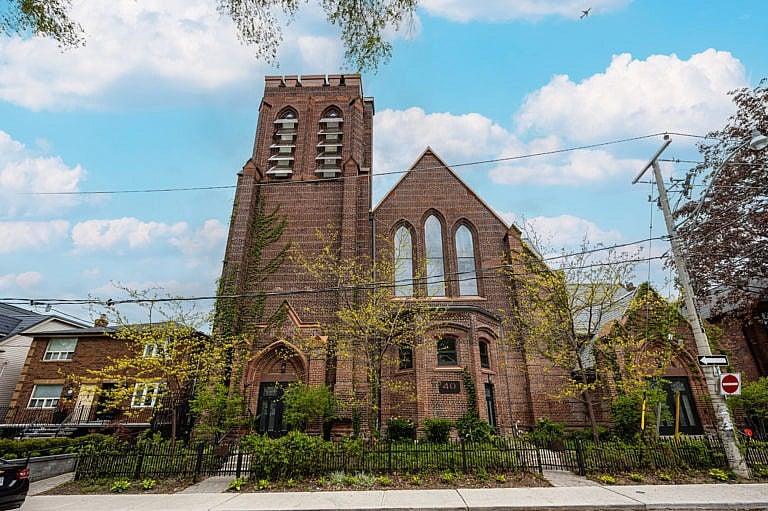An architect spent $16 million transforming this Toronto church into townhomes
One apartment is a seven-storey tower unit with timeless artifacts and sweeping views of the city

(Photographs courtesy of Open House Media)
Share

For years, the neo-Gothic St. Mary the Virgin church stood empty on Toronto’s Westmoreland Avenue. But where most people saw a derelict building, developer and architect Asen Vitko saw a multi-million-dollar opportunity. It was 2011, and he was captivated by the massive 29,000-square-foot building and its majestic seven-storey tower. The 123-year-old structure had once been a meeting ground for West Toronto’s Anglican parish, hosting school sessions during the week and mass on weekends for most of the 20th century. But as the congregation faded in recent decades, so did its stained-glass windows and brick facade.

A developer had already snapped up the church with plans to transform it into a residential complex, but renovations had been partly held up because the of the church’s historical designation, which meant that any changes would have to be approved by the City of Toronto’s Historical Preservation Services board. Vitko reached out to the developer, who agreed to sell him a section of the building, which included the tower. But within a month, the developer defaulted on the mortgage, and Vitko bought the rest of the church from the bank. “I believed in this place,” he says. “There were some timeless artifacts that I knew would eventually attract buyers who appreciate fine architecture.”

READ: This church-turned-house in small-town Ontario has a thoroughly modern interior

For two years, Vitko went back and forth with the heritage board on his proposals. At first, he wanted to swap the old wooden doors with glass ones—a request that was denied—and only received the green light after proposing to refurbish the church’s original wood-and-brick facade In 2013, he began converting the building into apartments. “I saw so much potential in slicing the inside into modern townhomes that would contrast old and new. It would be nothing like classic Toronto condos,” says Vitko.

Over the next three years, he refurbished the entire building. To remodel the interior, he had the concrete beams reinforced, walls re-sheared and floors redone—all with the goal of selling every unit except for the tower, which he wanted to keep for himself. He finished 16 townhouse-style units inside the church, many of which have two or three bedrooms and exposed brick, stained lancet windows and rustic wooden ceilings. The project’s price was astronomical—just replacing the stained-glass windows set him back $60,000, and he spent $1 million tuckpointing all the bricks. In total, the development cost him $16 million.

Many units in the church are now owned by doctors, lawyers and other professionals who wanted a taste of history in their homes. (One apartment is currently on the market for $1.5 million; it has an original arched brick wall with new chevron flooring.) Vitko’s own seven-storey tower unit wrapped up renovations in 2016. It has a private elevator and an oak staircase that spirals all the way up to a rooftop terrace with 360-degree views of the city.

READ: An Ontario couple converted this 130-year-old church into a charming family home

Each floor in his apartment has nods to the church’s past. There are original stone and glass vases that date to the early 1900s, and patches of century-old exposed brick in most rooms. In the kitchen, a 1920s stone plaque has 20 names of young church members who were drafted in the First World War and never made it home. On the third floor, where Vitko has his home office, a church pew is repurposed as a bookshelf. Two floors above is a lounge area with a 20-foot ceiling, where the church bell used to dangle until it was stolen a year before Vitko purchased the property. “It’s the ultimate bachelor pad,” he says. “Guests are amazed because every historical element has been preserved and exposed.”

Over the last seven years, Vitko has become used to people dropping by to admire the church’s revamped look. A tour bus once parked out front, and vacationers snapped photos through the vehicle’s windows. Outside on his patio, Vitko overheard the guide sharing some incorrect facts about the building, so he chimed in to correct them. “This was the largest historical restoration project I’ve undertaken, so I suppose I know it inside and out,” he says. “It was quite the undertaking, and I’m proud of it.”